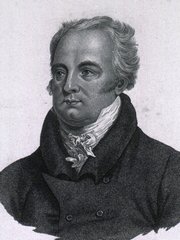This article is part of the series "A Moment in History" where we honor those who have contributed to the growth of medical knowledge in the areas of anatomy, medicine, surgery, and medical research.

Sir Astley Paston Cooper
Sir Astley Paston Cooper (1768 - 1841). An English anatomist and surgeon, Astley Cooper started his medical studies when he was only 16, at the St. Thomas hospital in London. He studied under Henry Cline, and later under John Hunter. Astley Cooper was a well-known anatomist, lecturer, and surgeon in his time. He is known for his many studies in abdominal hernia, otology, aneurysms, and the anatomy and diseases of the breast. In 1804 he described the abdominal transversalis fascia and the internal inguinal ring.
Born in the village of Brooke, Norfolk. At 16 years of age he was placed under the tutelage of Henry Cline (1750 - 1827), senior surgeon at the St. Thomas hospital in London for a seven-year apprenticeship. In 1789 he was appointed as an anatomy lecturer at the same hospital. In 1800 Cooper was appointed Surgeon to the Guy's Hospital in London.
He was the first to attempt the ligation of the abdominal aorta in a patient that had suffered an aortic abdominal aneurysm rupture. The patient survived for one additional day. "Astley Cooper introduced no new philosophy, policy or practice into surgery but was the perfect exponent of the scientific approach to surgery combined with skillful and successful practical ability" Brock (1969)
Cooper’s name survives in several eponymous anatomical structures and diseases he described, following are two of them:
• Cooper's ligaments of the breast: Connective tissue ligamentous strands between the pectoral fascia and the skin overlying the breast. (although it was first described by Andrea Vesalius).
• Cooper's pectineal ligament: A thickening of the periosteum on the superior aspect of the pubic bone, lateral to the pubic tubercle. This structure is a preferred site for staple positioning during a laparoscopic herniorrhaphy. When placing the staples, consideration should be placed on the potential presence of an anatomical vascular variation named the "Corona Mortis".
Although Cooper published a number of books and research papers, his seminal contribution to surgery was his two-volume "Treatise on Hernia". The first volume was published in 1795 and the second volume in 1807, with a revised second edition published in 1827.
Personal note: Although Sir Astley Cooper has been credited with the first description of the complex mammary suspensory ligaments (Cooper's ligaments), a 2016 paper by Brinkman and Hage (see Sources) contests this and gives Andreas Vesalius the honor of describing these structures nearly 300 years before Cooper! Dr. Miranda.
Sources:
1. "Sir Astley Paston Cooper." Singal, R. et al. Indian J Surg 73:1 (2011): 82-84.
2. "Sir Astley Paston Cooper, 1768-1841:the prince of surgery"Rawling, EG. Can Med Assoc J 99.5 (1968): 221.
3. "The life and work of Sir Astley Cooper" Brock, RC. Ann Royal Coll Surg England 44.1 (1969): 1-18
4. "Andreas Vesalius’ 500th Anniversary: First Description of the Mammary Suspensory Ligaments" Brinkman, RJ; Hage JJ. World J Surg (2016) 40:2144–2148



